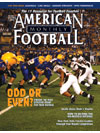AMERICAN FOOTBALL MONTHLY THE #1 RESOURCE FOR FOOTBALL COACHES
Article CategoriesAFM Magazine
|
Techniques and Drills for Pass Protectionby: Derek MooreOffensive Line Coach, Upper Iowa University © More from this issue At Upper Iowa, our offensive linemen go out before practice and then stay after to work on proper pass protection techniques. If these drills are instilled on a daily basis, the players can work on their own technique and know what results to expect. When I was hired in January of 2006, my first priority was to have our offensive linemen dedicate themselves to fundamentals and techniques. Last year our offensive line averaged 270 pounds and two of our starters had never played O-Line in their respective careers. At the end of last season, our offense finished number one in total offense in the Northern Sun Intercollegiate Conference and 15th nationally in Division II. We gave up 29 sacks in 400 passing attempts in 2006. Prior to my hiring, the offense gave up 40 in 200 passing attempts. This improvement was made possible by a great dedic....The full article can only be seen by subscribers. Subscribe today!
|
|
|||||||
| HOME |
MAGAZINE |
SUBSCRIBE | ONLINE COLUMNISTS | COACHING VIDEOS |
Copyright 2026, AmericanFootballMonthly.com
All Rights Reserved





